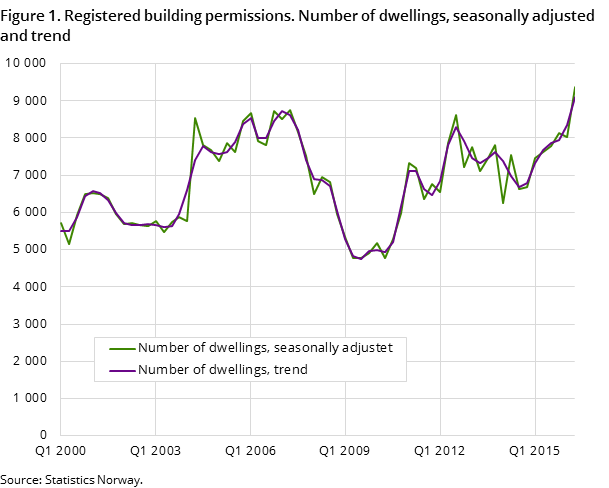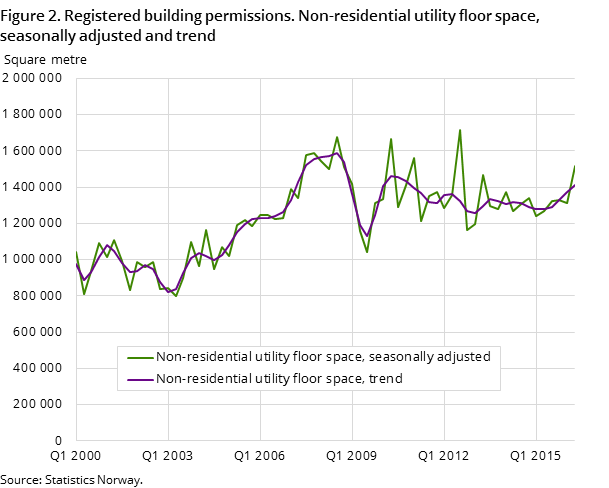Content
Published:
This is an archived release.
More dwellings and industrial buildings
Seventeen per cent more building start permits were given in the second quarter of 2016 compared with the first quarter of 2016, according to seasonally-adjusted figures.
| 2nd quarter 2016 | |||
|---|---|---|---|
| Seasonally adjusted | Unadjusted | ||
| Percentage change from the previous quarter | Percentage change from the same quarter previous year | Total | |
| Dwellings | 16.7 | 24.9 | 9 784 |
| Utility floor space, 1000 m2 | |||
| Dwellings | 5.6 | 12.2 | 1 186.2 |
| Other buildings | 15.6 | 19.7 | 1 647.2 |


For non-residential buildings, seasonally-adjusted figures show that building start permits increased by 16 per cent for utility floor space, from the first quarter to the second quarter this year.
9 800 new dwelling permits
In the second quarter of 2016, building start permits were given on 9 800 dwellings, with a total of about 1 186 000 square metres of utility floor space. New dwellings increased by 25 per cent compared with the second quarter of 2015.
New residences for communities had the greatest increase, with student dormitories constituting by far the greatest share. In the second quarter this year, the number of building permits for dwellings in residences for communities increased by 224 per cent compared with the second quarter of 2015. Compared with the second quarter of 2014, there is however a 27 per cent decrease in the number of building permits.
Most permits in Akershus county
The county of Akershus had the most dwelling start permits, with 1 237, followed by Oslo and Hordaland counties with 1 192 and 1 022 respectively.
Increase also in industrial sector
In the second quarter of 2016, building start permits were given on about 1 192 000 square metres of utility floor space within the industrial sector. This is an increase of 21 per cent compared with the same quarter in 2015.
359 demolished detached houses
In the second quarter of 2016, a total of 584 dwellings were demolished, of which 359 were detached houses. For buildings other than residential buildings, 1 170 buildings in the industrial sector were pulled down, and 331 holiday homes and 1 580 private garages were demolished.
New dwellings in old buildings
Dwellings constructed by converting existing building stock, for example through change in use of utility floor space, are not currently included in the building statistics. The plan is to publish these as from the third quarter of 2016.
Registered building permissionsOpen and readClose
Figures for buildings in the building statistics rely on dates for when permits are registered by the municipality in the data register (Matrikkelen). A building permit does not always mean that construction will be started at once. Especially in low conjunctures it might be that construction projects are not realised, or may be postponed after a building permit has been granted. When the building activity trend turns from a low to a high level, and vice versa, this could affect the interpretation of the statistics.
More details about comparability, quality and other information are available in About the statistics .
Rebuilding of existing building stockOpen and readClose
Building statistics do not cover dwellings due to rebuilding of existing building stock (i.e. new dwellings due to reconstruction of utility floor space from industry to dwellings).
When an old building is being demolished to the foundation wall, it is regarded as a new building. When the building framework is not demolished, it counts as rebuilding.
For more information, see About the statistics .
Contact
-
Jens Mathiesen
E-mail: jens.mathiesen@ssb.no
tel.: (+47) 40 81 13 98
-
Magnus Espeland
E-mail: magnus.espeland@ssb.no
tel.: (+47) 45 27 40 08
